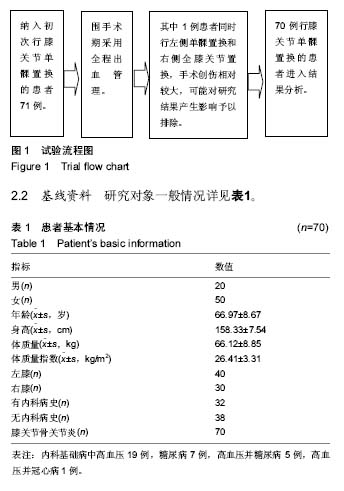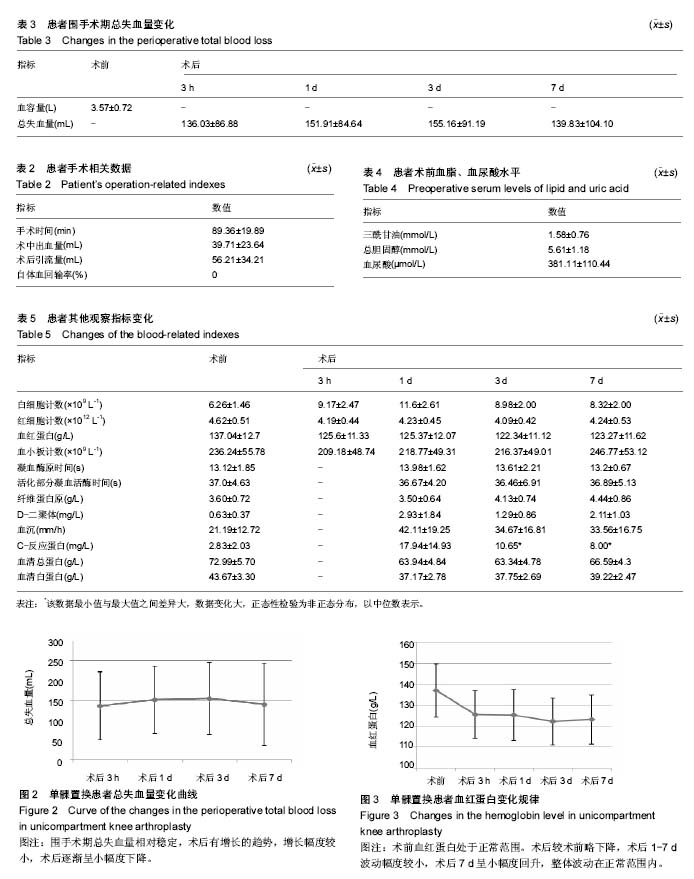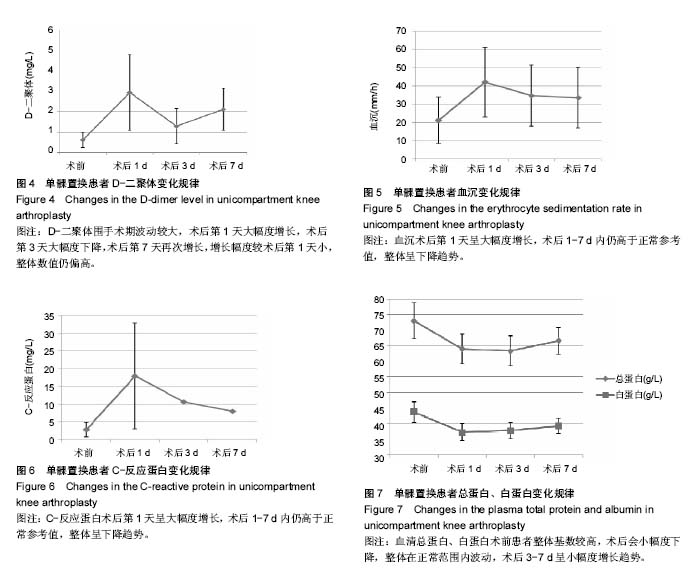| [1] 王一鸣, 王琦,张先龙. 膝关节单髁置换术的适应证及远期疗效综述[J]. 中华关节外科杂志电子版, 2016, 10(3): 88-92.[2] 张启栋,郭万首,刘朝晖,等. 内翻畸形膝骨关节炎软骨磨损的临床研究[J]. 中国矫形外科杂志, 2013, 21(23): 2345-2350.[3] Arno S, Maffei D, Walker PS, et al. Retrospective analysis of total knee arthroplasty cases for visual, histological, and clinical eligibility of unicompartmental knee arthroplasties. J Arthroplasty. 2011;26(8): 1396-403.[4] Satku K. Unicompartmental knee arthroplasty: is it a step in the right direction?--Surgical options for osteoarthritis of the knee. Singapore Med J. 2003;44(11): 554-556.[5] Craik JD, El Shafie SA, Singh VK, et al. Revision of unicompartmental knee arthroplasty versus primary total knee arthroplasty. J Arthroplasty. 2015; 30(4): 592-594.[6] Lyons MC, MacDonald SJ, Somerville LE, et al. Unicompartmental versus total knee arthroplasty database analysis: is there a winner? Clin Orthop Relat Res. 2012;470(1):84-90.[7] Faour-Martín O, Valverde-García JA, Martín-Ferrero MA, et al. Oxford phase 3 unicondylar knee arthroplasty through a minimally invasive approach: long-term results. Int Orthop. 2013;37(5): 833-838.[8] 景鹏举,王勇平,李兴隆,等. 膝关节单髁置换术治疗膝骨性关节炎有效性的meta分析[J]. 现代医药卫生, 2017,33(2): 180-183.[9] Longo UG, Loppini M, Trovato U, et al. No difference between unicompartmental versus total knee arthroplasty for the management of medial osteoarthtritis of the knee in the same patient: a systematic review and pooling data analysis. Br Med Bull.2015; 114(1): 65-73.[10] Arirachakaran A, Choowit P, Putananon C, et al. Is unicompartmental knee arthroplasty (UKA) superior to total knee arthroplasty (TKA)? A systematic review and meta-analysis of randomized controlled trial. Eur J Orthop Surg Traumatol. 2015;25(5): 799-806.[11] 刘义超. 单髁置换与全膝关节置换治疗膝单间室骨关节炎围手术期出血量的对比研究[D].新疆医科大学,2016.[12] Schwab PE, Lavand'homme P, Yombi JC, et al. Lower blood loss after unicompartmental than total knee arthroplasty. Knee Surg Sports Traumatol Arthrosc. 2014;23: 1-7.[13] McGrory B, Weber K, Lynott JA, et al. The American Academy of Orthopaedic Surgeons Evidence-Based Clinical Practice Guideline on Surgical Management of Osteoarthritis of the Knee. J Bone Joint Surg Am. 2016;98(8): 688.[14] Thompson SA, Liabaud B, Nellans KW, et al. Factors associated with poor outcomes following unicompartmental knee arthroplasty: redefining the "classic" indications for surgery. J Arthroplasty. 2013; 28(9):1561-1564.[15] 岳辰,周宗科,裴福兴,等. 中国髋、膝关节置换术围术期抗纤溶药序贯抗凝血药应用方案的专家共识[J]. 中国骨与关节外科, 2015,8(4): 281-285.[16] 徐逸生,张智勉,魏超,等. 针对性止血应用于膝关节置换术的临床观察[J]. 中国输血杂志,2016,29(2): 162-165.[17] Hong KH, Pan JK, Yang WY,et al. Comparison between autologous blood transfusion drainage and closed-suction drainage/no drainage in total knee arthroplasty: a meta-analysis. BMC Musculoskelet Disord. 2016;17:142. [18] Shen HL, Li Z, Feng ML, et al. Analysis on hidden blood loss of total knee arthroplasty in treating knee osteoarthritis. Chin Med J (Engl). 2011;124(11):1653-1656. [19] Nadler SB, Hidalgo JH, Bloch T. Prediction of blood volume in normal human adults. Surgery.1962;51(2):224-232.[20] Felson DT, Naimark A, Anderson J,et al. The prevalence of knee osteoarthritis in the elderly. The Framingham Osteoarthritis Study. Arthritis Rheum. 2010;30(8):914-918.[21] Kang X, Fransen M, Zhang Y, et al. The high prevalence of knee osteoarthritis in a rural chinese population: The Wuchuan Osteoarthritic Study (vol 61, pg 641, 2009). Arthritis Rheum. 2009;61(7):1008-1008.[22] Jiang L, Tian W, Wang Y, et al. Body mass index and susceptibility to knee osteoarthritis: a systematic review and meta-analysis. Joint Bone Spine Revue Du Rhumatisme. 2012;79(79):291-297.[23] Blagojevic M, Jinks C, Jeffery A, et al. Risk factors for onset of osteoarthritis of the knee in older adults: a systematic review and meta-analysis. Osteoarthritis Cartilage. 2010;18(1): 24-33.[24] Lim YZ, Wang Y, Wluka AE, et al. Association of obesity and systemic factors with bone marrow lesions at the knee: A systematic review. Semin Arthritis Rheum. 2014;43(5):600-612. [25] 薛华明,马童,文涛,等. 髌旁外侧入路外侧单髁置换术治疗膝关节外侧间室骨关节炎[J]. 中国修复重建外科杂志, 2015,29(1):19-23.[26] 邱旭升,陈东阳,徐志宏,等. 全膝关节置换术后隐性失血危险因素的分析[J]. 实用骨科杂志, 2012, 18(6): 510-512.[27] Hu KZ, Sun HY, Sui C. Effects of five treatment regimens on blood loss and blood transfusion in total knee arthroplasty: a preliminary study in China. Int J Clin Pharmacol Ther. 2017;55(5):433-441. [28] Chen TP, Chen YM, Jiao JB, et al. Comparison of the effectiveness and safety of topical versus intravenous tranexamic acid in primary total knee arthroplasty: a meta-analysis of randomized controlled trials. J Orthop Surg Res. 2017;12(1):11.[29] Zhang XQ, Ni J, Ge WH. Combined use of intravenous and topical versus intravenous tranexamic acid in primary total joint arthroplasty: a meta-analysis of randomized controlled trials. Int J Surg. 2017;38:15-20.[30] 徐飞,吕永明,宋莺春,等. 氨甲环酸对膝关节置换术后血红蛋白降低的临床研究[J]. 中国临床药理学杂志, 2015,31(13): 1246-1248.[31] Cid J, Lozano M. Tranexamic acid reduces allogeneic red cell transfusions in patients undergoing total knee arthroplasty: results of a meta-analysis of randomized controlled trials. Transfusion. 2005;45(8): 1302-1307.[32] 梁峰,许晓军,姚强,等. 全膝关节置换术后CRP和ESR变化的临床研究[J]. 中国骨与关节损伤杂志, 2014, 29(1): 73-74.[33] 刘安,陈廖斌,王欣,等. 膝髋关节置换术围手术期血浆D-二聚体动态监测及临床意义[J]. 中华关节外科杂志电子版, 2013, 7(2): 145-149.[34] Rafee A, Herlikar D, Gilbert R, et al. D-Dimer in the diagnosis of deep vein thrombosis following total hip and knee replacement: a prospective study. Ann R Coll Surg Engl. 2008;90(2):123-126. [35] An TJ, Engstrom SM, Oelsner WK, et al. Elevated d-Dimer is not predictive of symptomatic deep venous thrombosis after total joint arthroplasty. J Arthroplasty. 2016;31(10): 2269-2272.[36] Xie J, Ma J, Huang Q, et al. Comparison of enoxaparin and rivaroxaban in balance of anti-fibrinolysis and anticoagulation following primary total knee replacement: a pilot study. Med Sci Monit. 2017;23: 704-711.[37] Ricket AL, Stewart DW, Wood RC, et al. Comparison of postoperative bleeding in total hip and knee arthroplasty patients receiving rivaroxaban or enoxaparin. Ann Pharmacother. 2016;50(4):270-275.[38] Ning GZ, Kan SL, Chen LX, et al. Rivaroxaban for thromboprophylaxis after total hip or knee arthroplasty: a meta-analysis with trial sequential analysis of randomized controlled trials. Sci Rep. 2016; 6: 23726.[39] 陈呈锦. 人工全膝关节置换术后早期低蛋白血症的高危因素回顾性研究[D].昆明医科大学,2014.[40] Kamath AF, Nelson CL, Elkassabany N, et al. Low albumin is a risk factor for complications after revision total knee arthroplasty. J Knee Surg. 2017;30(3):269-275. |
.jpg)



.jpg)